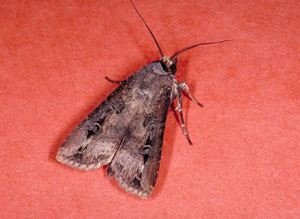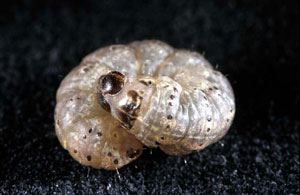Cool And Wet Can Only Help Cutworms
DR. DOUG JOHNSON
PRINCETON, KY.
Capture of black cutworm moths in the IPM traps has been above the
rolling 5-year average for the last several weeks. The activity of this
insect has been notoriously difficult to predict over the years, even
with years of data on flight activity. Nevertheless given that the moth
capture is above “normal” and we are experiencing unusually cool and
damp weather, it may be that we should keep a closer check on our young
corn plants.

Figure 1. Black cutworm moth.
Photo: Doug Johnson, UK
Corn products that have the latest edition of “Bt” traits will be
afforded quite a bit of protection from this pest. However, corn that
does not contain “Bt” or that contains only the first generation “corn
borer Bt” traits will be at greater risk if an economically important
population occurs. Our traps are unlikely to provide a definitive
warning, so scouting for the damaging caterpillars is the best way to
insure that major loss will not occur.
Cutworm larvae (Figure 2) are light grey to nearly black and may have
a faint, narrow mid-dorsal stripe. Larvae vary from ¼” long after hatch
to 1 ¾ ” when full-grown. Larger larvae tend to curve themselves into a
“C” shape around the plant and wiggle vigorously when handled. Damage
symptoms are cut or wilted plants.

Figure 2. Black cutworm larva.
Photo: Purdue University
Scouting should begin from a randomly selected starting point.
Examine 20 consecutive plants per location and record the number of cut
plants. This should be done at multiple locations (at least five) in the
field. Determine the percent cut plants by dividing the total number of
plants cut by the total number of plants inspected and multiply by 100.
If an average of 3 percent cut plants plus 2 or more live cutworms
(1” or smaller) per 100 plants examined are found, a control should be
considered. Remember if you cannot find live larvae, the population may
have already completed a generation and control is not warranted. ∆
DR. DOUG JOHNSON: Extension Entomologist, University of Kentucky